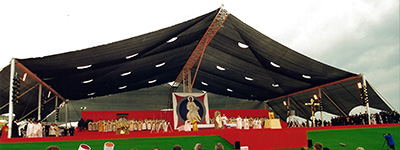
In Plato the theology of beauty has a fundamental role: the awe for beauty awakens in man the memory of his divine origin and gradually helps him to undertake once more the navigation towards God. The Primitive Church, proclaiming the incarnation of God, reveals that “beauty” has dressed itself in mortal flesh:
«True light came into the world...
and the Word became flesh and dwelt among us, and we saw its glory, the glory of an only begotten son from the Father, full of grace and truth» [1]
Psalm 45 is fulfilled:
«You are the most beautiful from among the sons of man, Grace is poured on your lips...» [2]
But the incarnation remains a scandal, because for for the pagan or for the rational mind, beauty cannot take
 «sensible shape...
«sensible shape...
and among fleeting forms to feel the sighs of a mournful life...
here where years are short and unhappy» [3]
The incarnation of beauty enables man to receive a new nature.
Already the Old Testament announces the bond between conversion and the restoration of original beauty: the beauty of Eve is a type of the human situation before original sin. Adam finds a partner in the creation only when God creates Eve. Adam is surprised in front of her beauty:
«Here is truly flesh of my flesh, Bone of my bones.» [4]
When Moses leads the people to the foot of Mt. Sinai so that they may receive the Torah, Scripture and rabbinical tradition present this meeting as a new marriage between God and his people. Through a washbowl [5] of regeneration, the people filled with diseases, ugliness, and defects caused by sin and slavery, are reconstituted to the original beauty of Eve: the rabbis write that:
«The blind regained their sight, the lame could walk, the lepers were healed, the deaf could hear once more,...»
God, seeing the beauty of the new Eve could exclaim like Adam:
«Here you are flesh of my flesh.»
The same language of beauty is used in the Song of Songs to describe the love of God towards his people:
«How beautiful you are, my friend, how beautiful you are! Your eyes are like doves» [6]
To John the Baptist who asks testimony from him, Jesus answered with the same words of Isaiah:
«Go and tell John what you have heard and seen: the blind see, the lame walk, the lepers are healed...» [7]
In the primitive Church Iconography is the testimony of the Incarnation: the face of Christ can be represented because God clothed himself with our flesh.
 But the contemplation of the beauty of the face of Christ awakens in man his true nature: Christians through baptism become new men, manifesting to the world true love, that is love to the enemy, love to the point of giving up one’s life for the other.
But the contemplation of the beauty of the face of Christ awakens in man his true nature: Christians through baptism become new men, manifesting to the world true love, that is love to the enemy, love to the point of giving up one’s life for the other.
«We know that we have passed from death to life because we love the brothers.» [8]
For this reason there is a tight bond between beauty and evangelization: the beauty of the face of Christ is translated into the beauty of the Christian community, the living body of Christ in history. It is the community, which reveals the beauty of God’s nature in communion and forgiveness. Jesus says:
«He who sees me has seen the Father» [9]
So he who sees the Christian community, where the love to the enemy appears, sees the true icon of Christ.
In the course of history, the Church has always perceived this bond between beauty and evangelization. The Church along the centuries has been the greatest producer of beauty. Everything reflects the beauty of Christ and the beauty of the community and of fraternal communion. The evangelization of Slavic peoples was made especially through the beauty of the liturgy, of the icons and of the songs.
Only in these last years, even within the Church, there seems to prevail a functional vision. This vision reduces the places where the community lives, meets and gathers, to simple meeting-rooms.
Today, more than ever, it is necessary and urgent that the structures of the Church may be renewed. The answer to the global village, to the Great City, to the mono-culture, is a parish that may become a “heavenly village”. A social model that is more human and capable of opening spaces for the new civilization of love, a Eucharistic assembly that may favor the active participation of the faithful, a reality of community with a catechumenium composed of beautiful liturgical rooms for celebrations in small communities.


The project of Domus Galilaeae and the tent where the Pope celebrated the Eucharist on March 24th on the Mount of Beatitudes, are an attempt to rediscover architectural and iconographic shapes that may help to reintroduce beauty into the life of the Church.
References
[1] John 1,3; The New Jerusalem Bible, Doubleday press.
[2] Psalm 45,2; The New Jerusalem Bible, Doubleday press.
[3] Giacomo Leopardi, Hymn to his Woman.
[4] Genesis 2,23; The New Jerusalem Bible, Doubleday press.
[5] Exodus 19,10-14; The New Jerusalem Bible, Doubleday press.
[6] Song of Songs 4,1; The New Jerusalem Bible, Doubleday press.
[7] Luke 7,22-23; The New Jerusalem Bible, Doubleday press.
[8] First Letter of John 3,14; The New Jerusalem Bible, Doubleday press.
[9] John 1,3; The New Jerusalem Bible, Doubleday press.
